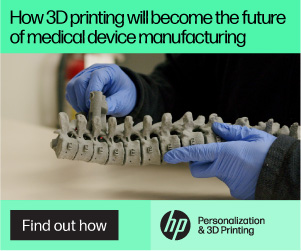 There have been plenty of 3D printing research projects in terms of developing materials and products that can hold up under high temperatures, such as boron nitride nanotubes, 3D printer nozzles made out of tungsten, and 3D printed sensors that can detect wildfires and chemical leaks. Two years ago, the University of Pittsburgh Swanson School of Engineering received over $1 million to research 3D printing technology and how it could be used to develop durable material coatings for turbines that can withstand challenging, high temperature environments. Now, the professor in charge of that ongoing project has received additional funding so the research can continue.
There have been plenty of 3D printing research projects in terms of developing materials and products that can hold up under high temperatures, such as boron nitride nanotubes, 3D printer nozzles made out of tungsten, and 3D printed sensors that can detect wildfires and chemical leaks. Two years ago, the University of Pittsburgh Swanson School of Engineering received over $1 million to research 3D printing technology and how it could be used to develop durable material coatings for turbines that can withstand challenging, high temperature environments. Now, the professor in charge of that ongoing project has received additional funding so the research can continue.

Dr. Chyu (R) examining an investment casting airfoil with former PhD student Sean Siw, who now works at Siemens Energy in Orlando on blade cooling tasks.
Dr. Minking Chyu, Distinguished Service Professor and the Leighton and Mary Orr Chair Professor of Mechanical Engineering and Materials Science at Pitt’s Swanson School of Engineering, has received $777,192 for the “Integrated Transpiration and Lattice Cooling Systems Developed by Additive Manufacturing with Oxide-Dispersion-Strengthened Alloy” study from the US Department of Energy (DOE). The DOE’s Office of Fossil Energy (FE) awarded the university $600,000, with a $177,192 cost-share coming from the university itself.
The DOE FE funds R&D projects that encourage sustainable approaches to fossil resources, as well as improve advanced fossil energy technologies. Dr. Chyu and his team will be researching anti-oxidation coating applications, working with the same Oxide Dispersion-Strengthened (ODS) Alloys they studied two years ago, in an effort to use 3D printing technology to improve gas turbines, which generate power for multiple applications, such as electricity production and jet engine propulsion.
“A gas turbine is a type of internal combustion engine that mixes air, fuel, and combustion to rapidly spin fan-shaped blades—or airfoils—and create mechanical energy,” explained Dr. Chyu, who is also the Associate Dean for International Initiatives at the Swanson School and Dean of the Sichuan University – Pittsburgh Institute in Chengdu, China. “While generating enormous amounts of energy, gas turbines also generate enormous amounts of heat and are at risk of being damaged by these high-temperatures.”
This heat can severely damage turbines, and shorten their lifespan. We’ve seen 3D printing used to make blades and other components for gas turbines before, and by using the technology in this study, rather than investment casting, the research team hopes to coat the turbine airfoils with a cooling structure, built inside the ODS layer, that can offer protection from the extremely high temperatures that turbines are subjected to.
 Dr. Chyu’s 3D printing ODS alloy study is just one of nine turbine research projects that the DOE FE chose to receive $5.4 million in federal funding as part of its competitive University Turbine Systems Research (UTSR) program, which is managed by the National Energy Technology Laboratory (NETL). The NETL works to advance turbine technologies for a multitude of purposes, including reducing emissions, increasing energy efficiency, and improving performance.
Dr. Chyu’s 3D printing ODS alloy study is just one of nine turbine research projects that the DOE FE chose to receive $5.4 million in federal funding as part of its competitive University Turbine Systems Research (UTSR) program, which is managed by the National Energy Technology Laboratory (NETL). The NETL works to advance turbine technologies for a multitude of purposes, including reducing emissions, increasing energy efficiency, and improving performance.
The researchers will be studying the anti-oxidation coating to determine applications that are able to cool down airfoils in gas turbines, along with other hot-section components. The ODS alloys can hopefully be used to make blades more heat-resistant, which will offer them protection in the hot environment of the turbine.
“The alloys we’re developing increase the melting point of the turbine’s components, and therefore, improve their heat resistance,” said Dr. Chyu. “Additive manufacturing enables us to create complex lattice structures that allow cool air to enter the turbines and reduce temperature even further.”
The plan is to combine the alloys with 3D printed lattices and transpiration cooling systems. Lightweight lattice structures have long been used in construction, due to their strength and low density, and 3D printed lattices have helped in the creation of customized shoes and bone tissue engineering. By pairing them with the ODS alloys and cooling systems, turbines can be operated at higher temperatures, with better efficiency, while being less likely to suffer from heat damage.
Discuss this and other 3D printing topics at 3DPrintBoard.com or share your thoughts below.
[Source: University of Pittsburgh]
Subscribe to Our Email Newsletter
Stay up-to-date on all the latest news from the 3D printing industry and receive information and offers from third party vendors.
You May Also Like
Purdue Teams Power 3D Printed Rocket Chamber with Elementum 3D’s Aluminum Powder
Self-landing rockets essentially changed the space sector, transforming it from a niche research segment to fully fledged industry. To continue driving the technology forward, new generations of engineers are expanding...
BMW Targets WAAM 3D Printed Test Parts for Vehicles Next Year
The BMW Group has long been a user and innovator in additive manufacturing (AM) technology, dating back nearly 35 years. Nevertheless, the auto giant never fails to impress in the...
Blue Laser Firm NUBURU Explores Strategic Alternatives Amid NYSE Compliance Challenges
In a strategic move reflecting the current macroeconomic landscape, NUBURU, Inc. (NYSE American: BURU), a pioneer in industrial blue laser technology, has announced its decision to explore a wide array...
Elementum 3D Receives $2.875M to Lead Aluminum 3D Printing Research
Elementum 3D, a Colorado-based additive manufacturing (AM) company specializing in metals development, has been awarded $2.875 million by Manufacturing USA institute America Makes for the “Proliferation of AM Aluminum Alloy...
































